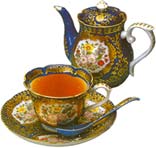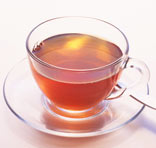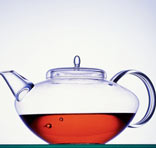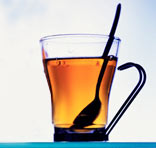| |
 |
What
is about tea that we like so much? First of all,
we enjoy the comfort of a warm drink. There is also
the fact that most tea is very inexpensive. But,
more specifically, black tea leaf gives off a pleasant
aroma, its infusion has an attractive red colour,
and the drink has an agreeable, slightly astringent
taste and delivers a stimulating lift afterwards.
|
| These
characteristics all arise from the various chemicals
in the leaf, which include amino acids, carbohydrates,
mineral ions caffeine and, especially, various polyphenolic
components which are sometimes incorrectly called
tannins. |
PRODUCING BLACK TEA
To understand the chemistry of
tea, we need to start with the tea plant, Camellia sinensis.
It is now grown in large, actively managed plantations.
Every few days, depending on the weather conditions,
large numbers of workers pluck the terminal bud and
the top two or three leaves of each plant. This tea
'flush’ contains 75-80% water, and the first stage
in the manufacturing process-called withering-reduces
the moisture content to 60-70% by a flow of cool air.
| The second
stage is the crucial one. Here the leaf is broken
up physically by a mechanical process, such as rolling
(the orthodox method), or crushing, tearing and
curling with contra-rotating rollers (the CTC method).
The CTC method produces smaller and more physically
disrupted leaves, which are used in teabags.The
tea is then allowed to 'ferment’ in air for
1-3 hours, originally in a thin layer on the |
 |
floor, but in more recent times in thicker layers with
a forced air supply. During fermentation, the polyphenolic
flavanols (or catechins) in the green tea are oxidized
by the oxygen in the air to form aroma constituents
and higher molecular weight polyphenolics-especially
the theaflavins which give the tea brew its red coloration,
and the dark thereubigins responsible for much of the
'mouthfeel’ of tea.
This oxidation comes about through
the catalytic action of an enzyme called polyphenol
oxidase. In the green leaf this enzyme is physically
separated from the flavanols, but the maceration of
the leaf brings them into contact and allows the oxidation
to proceed.
Once the oxidation has run its course,
the enzyme is deactivated by passing hot air over the
tea leaves. This third stage of the manufacturing process,
called firing, also develops some of the flavour characteristics
of the black tea and reduces the water content to ca3%.
The dried tea is then sorted into different grades by
passing it over a series of vibrating screens of different
grades by passing it over a series of vibrating screens
of different mesh sizes. Electrostatically charged rollers
preferentially attract and remove stalk and fibre. The
colourful names of grades, like Broken Orange Pekoe,
are simply indications of the size of leaf and the mechanical
method used in the second stage.
The processed black
tea has traditionally been packed and shipped in foil-lined
plywood tea chests. However, slow oxidation continues
during the months of transport and storage, and introduces
undesirable flavour characteristics. Recent research
has shown that such oxidative deterioration can be greatly
reduced by using nitrogen flushing or vacuum packs.
Tea protected in this way is now on the market and has
a fresher taste.
TEA 'FERMENTATION'

|
Some
25% of the dry weight of green tea is made up of
polyphenolic flavanols which, in the tea world,
are often called catechins. They are colourless,
water-soluble compounds with an astringent taste.
Flavanols all contain two aromatic rings linked
by an aliphatic C3 chain, and some have a galloyl
group (3,4,5-trihydroxybenzoyl) attached. Epigallocatechin
gallate is the predominant flavanol in green tea.
|
In the so-called 'fermentation’
process, the enzyme polyphenol oxidase catalyses the
oxidation of these flavanols to quinines, which then
react with each other. One set of products is theaflavin
in its mono – and digallated forms – these
structures all include an unusual seven-membered ring.
Although black tea contains less than 2% theaflavins,
their bright orange-red colour lends a distinctive hue
to infusions of tea. Theaflavins can be determined spectrophotometrically
by extracting them from the tea brew with isobutyl methyl
ketone and then reacting them with flavognost (2-aminoethyl
diphenylborate) to form a bright green complex.
Some 75% of the original catechins in
the green tea are converted to a complex and still incompletely
characterized group of substances known as thereubigins
because of their red-brown colour. They constitute the
largest group of compounds in black tea – upto
20% of its dry weight and 30-60% of the soluble material
in tea brew.
Even more complex is the aroma of black
tea. Although the volatile components account for less
than 0.2% by weight of the leaf, over 550 individual
chemicals have so far been identified by gas chromatography
coupled with mass spectrometry. Over 40 hydrocarbons,
70 alcohols, 70 aldehydes, 80 carbonyl compounds, 70
acids and 80 esters have been characterized in black
tea aroma, as well as more than 60 nitrogen-containing
compounds, 20 sulphur-containing compounds and 50 miscellaneous
oxygen-containing chemicals. Some of these compounds
originate directly from the green leaf, but most are
formed during tea processing. The aroma components strongly
affect the flavour of a cup of tea through our sense
of smell. However, the taste or mouthfeel of the tea
brew derives mainly from the various tea polyphenolics
modified by caffeine.
CAFFEINE
| This
is one of the most important chemicals in tea and
acts as a mild stimulant. Tea leaf contains about
4% Caffeine and a typical cup of tea, 40±10mg.
On average, a cup of instant coffee contains ca
60 mg caffeine and one of ground roast coffee, 85
mg. A cup of coffee drunk in the evening is therefore
more likely to keep you awake than a cup of tea.
|
 |
Caffeine is also a participant in a curious
phenomenon. When a cup of black tea (without milk!)
is cooled to below ca 400C, a colloidal precipitate
appears which is called 'tea cream’. This is mainly
the result of weak complexation between caffeine and
theaflavins and thearubigins. It has been suggested
that a similar association between the milk protein
casein and the various polyphenolic tea compounds could
explain why milky tea is less astringent on the tongue
than tea without milk.
THE EFFECT OF WATER

|
The look
of a cup of tea as well as its taste are significantly
affected by the water used to make it. Tea brewed
in distilled water, most soft water or even permanently
hard water (which contains CaSO4) appears brighter
than if it is brewed in temporary hard water. The
latter has passed through beds of limestone and
so contains calcium bicarbonate via the reaction
: CaCO3(s) + CO2 + H2O = Ca2+ + 2HCO3 |
The higher pH of the bicarbonate-containing
water causes greater ionization of the tea polyphenols,
thus changing their spectra and making the infusion
look darker brown. (Repressing polyphenol ionization
by adding acid, as in lemon tea, turns the tea infusion
yellow. Indeed, tea has been suggested as a teaching
model for acid-base indicators). As regards taste, some
teas are more suited to soft water, such as the orthodox
manufactured Assam leaf, while higher-grown Ceylon and
CTC manufactured teas are better with temporary hard
water, as in London.
Many people living in areas of temporary
hard water notice that their tea brew develops a dark
skin or scum on the top. This phenomenon has recently
been investigated in laboratories, where they deliberately
grew large quantities of scum in big beakers kept hot
for several hours. It turns out that, under the influence
of calcium and bicarbonate ions, tea solubles are further
oxidized at the liquid-air interface to form higher
molecular weight products. This is what most of the
scum consists of, together with some reformed CaCO3.
One can avoid scum formation by removing either the
calcium ions (for instance, by running the tap water
through a filter containing a cation exchange resin),
or the bicarbonate ions (by adding acid to convert HCO3
to CO2). Thus there is no scum on lemon tea, since the
citric acid in lemon juice reacts with the bicarbonate
ions as well as complexing the calcium ions.
Suprisingly, very little scum forms on
a cup of very strong tea because the acidic tea polyphenols
themselves partly neutralize the bicarbonate ions. It
should be emphasized that in ordinary tea brewing, less
than one milligram of scum is formed.
THE INFUSION PROCESS
| The concentration
(c) of caffeine (or indeed, of any tea soluble)
increases with the time (t) when tea leaf is infused
in water at constant temperature. The rate of increase
of concentration progressively falls off with time
until the concentration reaches an equilibrium value
(c ) after a few minutes.At this stage, the caffeine
is partitioned between the tea brew and the tea
leaves which have absorbed a large amount of water,
almost three times their dry weight. |
 |
The partition constant, K, is given by
:
K = equilibrium concentration in the
tea brew
equilibrium concentration in swollen tea leaf
The values of K lie between 0.1 and 0.7,
depending on the constituent. The fact that the swollen
tea leaves still contain a large quantity of tea solubles
is the reason why we can squeeze a second cup of tea
out of the teapot by pouring more hot water into it.
However, the composition of the tea infusion in the
second cup is not quite the same as in the first cup
because the partition constants of the various tea solubles
differ.
Experiments done under carefully controlled
conditions then showed that the infusion rate constant
:
- increases with decreasing size of tea leaf;
- is about twice as large for leaf treated by the
more severe
CTC manufacturing method than for leaf processed by
the orthodox method;
- rises by ca 3.7% for every 10 C rise in brewing
temperature;
- does not depend on the degree of stirring of the
water.
- Only when teabags are used, faster stirring increases
the brewing rate.
These experiments led to the conclusion
that the rate-determining step in tea brewing is the
slow diffusion of caffeine (and other tea solubles)
through the swollen tea leaf.
TEA AND HEALTH
 |
Of
the several hundred different compounds in black
tea, the most important are the polyphenols: flavanols,
theaflavins, thearubigins. These compounds are
able to bind iron in non-haem forms.
On a more positive note, these polyphenols can
play a beneficial role as antioxidants. Like vitamin
C, they can act against oxygen radicals which
have been implicated as |
of certain degenerative diseases of the
body. Evidence now accumulating appears to show that
the polyphenols in tea, especially (-) epigallocatechin
gallate (1), can reduce the risk of cancer and heart
disease, and an international research programme has
been set up to study the subject further.
Tea is therefore not only a pleasant drink,
it may also be good for your health.
|
|

